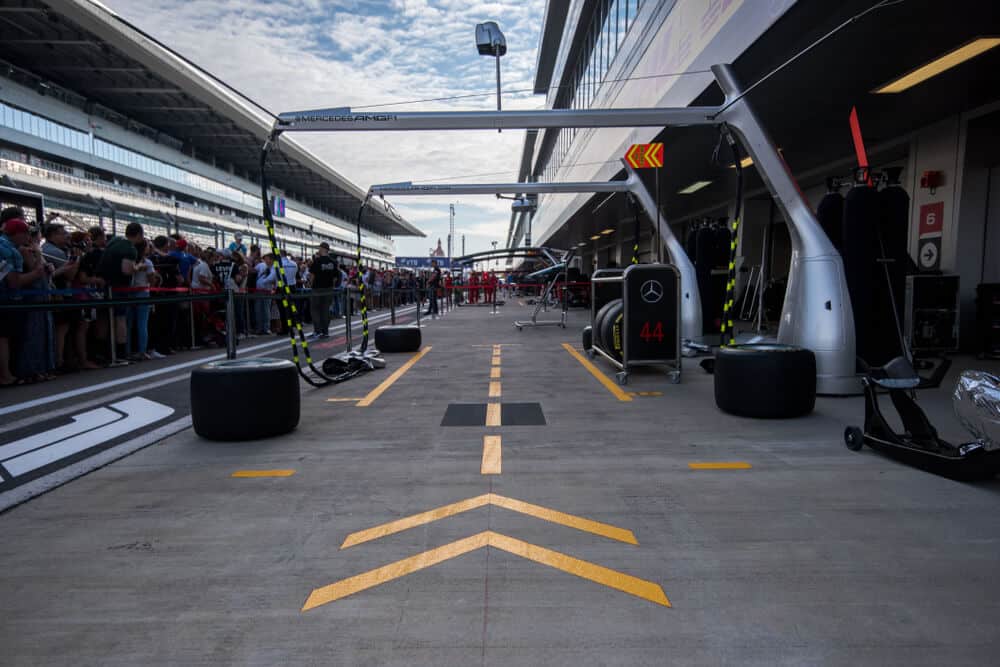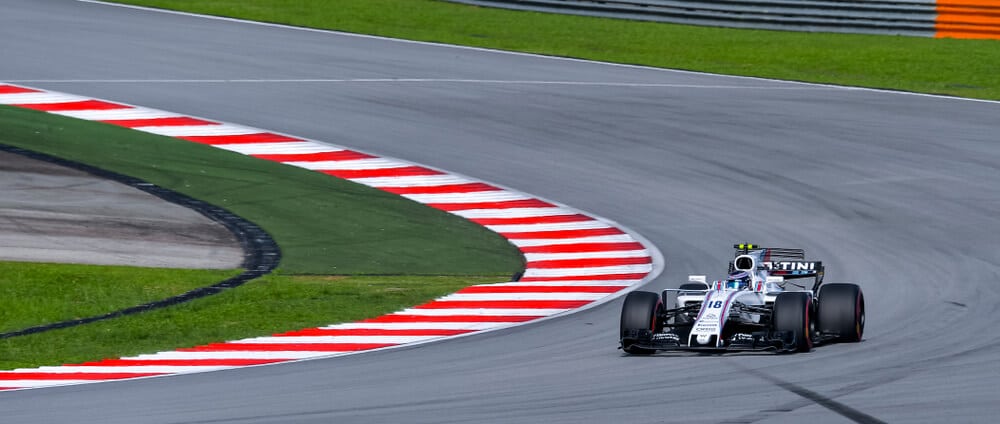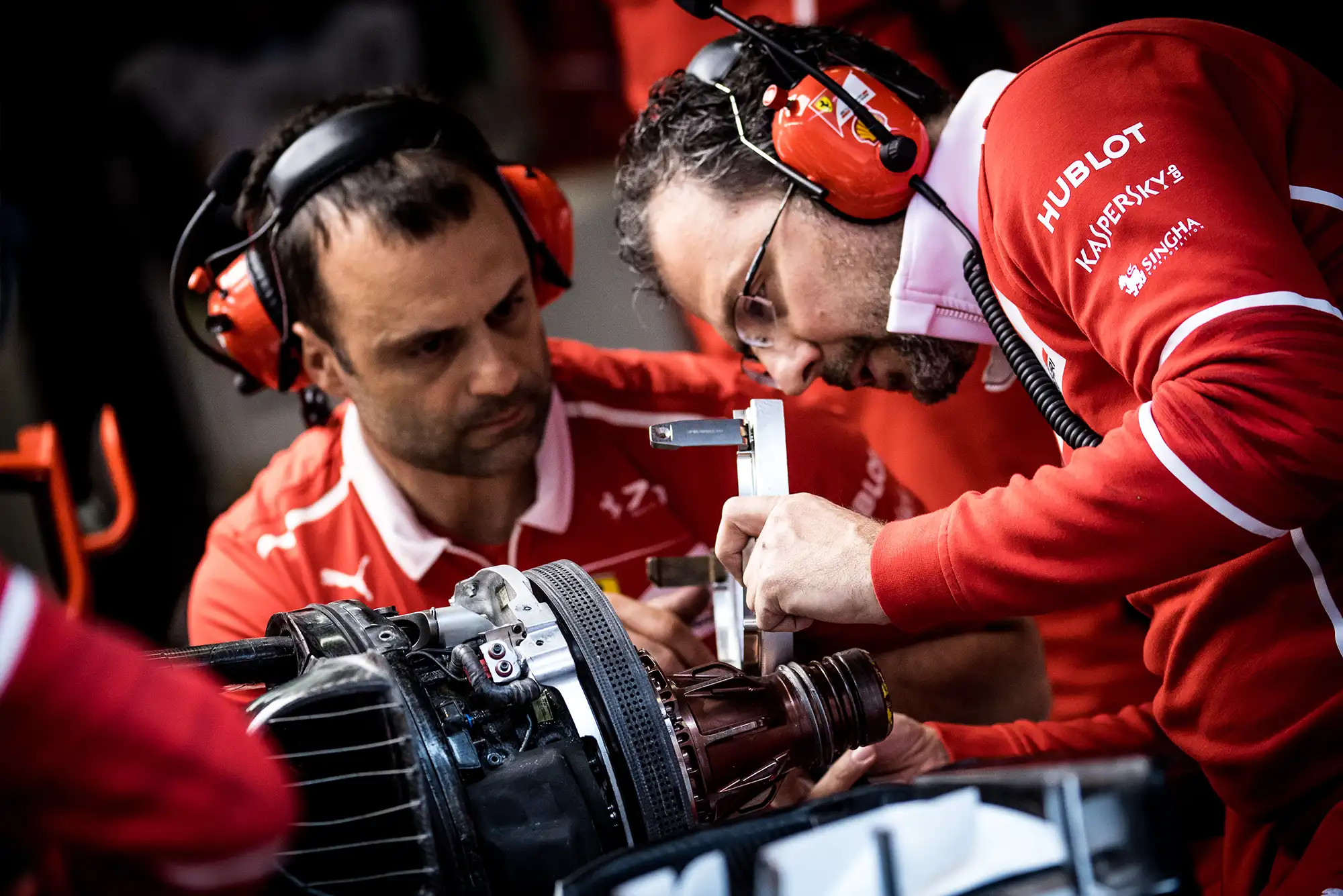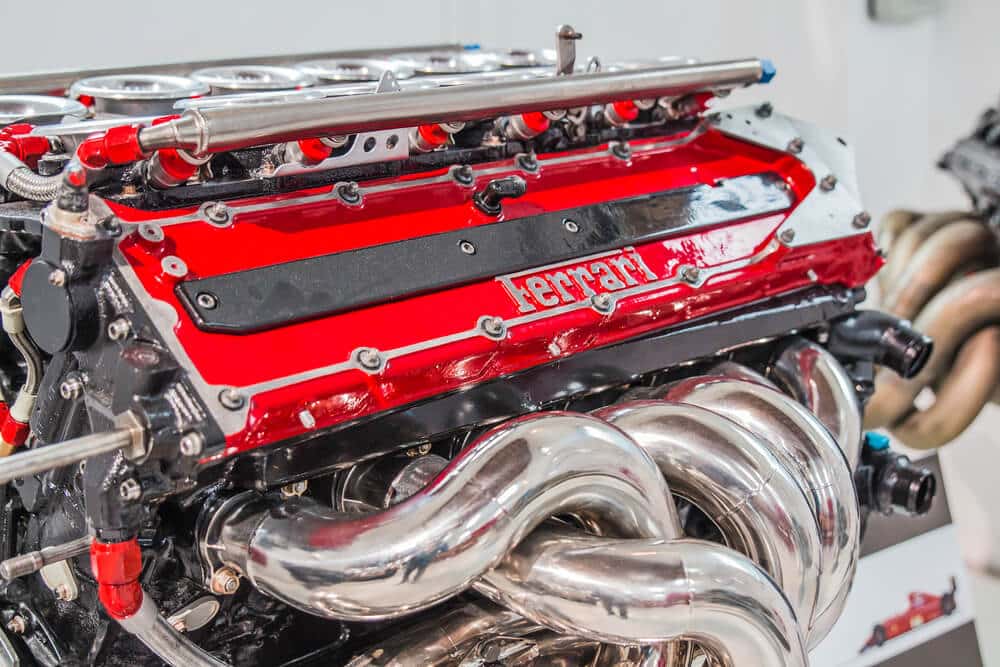Welcome to our article about the pit lane in Formula One. Pit stops are a fundamental part of Formula One racing, and the pit lane is where all the action happens. Pit stops are often the deciding factor in a race, and a team’s ability to execute a quick and efficient pit stop can make all the difference.
The pit lane is where teams make their strategic moves. Mechanics and engineers working together to ensure the driver’s car is in the best possible condition to continue the race. We’ll take a closer look at the pit lane, including its layout , pit stop procedures, pit stop strategies, safety regulations, and more.
Safety is a top priority in the pit lane. We’ll examine the regulations and procedures in place to ensure that the pit crew and drivers are kept safe during the race. Whether you’re a seasoned Formula One fan or a newcomer to the sport, our article is a must-read!
Table of Contents
Watch this video to learn more about different regulations regarding the pit lane.
What is a Pit Lane in F1?
The pit lane is a designated area located alongside the race track. It’s where drivers can make pit stops during a Formula 1 race.
Typically it consists of a narrow strip of tarmac flanked by rows of pit boxes. That’s where teams can carry out repairs, change tires, or refuel their cars. Pit lane speed limits are enforced to ensure the safety of the pit crew and official. Drivers must observe these speed limits while driving in the pit lane.
Importance of pit stops in Formula One
Pit stops are a crucial aspect of Formula One racing and play a significant role in determining the outcome of a race. Teams must decide when to pit their drivers based on tire wear, fuel consumption, and overall race strategy. A well-executed pit stop can mean the difference between winning or losing a race.
Teams spend countless hours perfecting their pit stop procedures. The pit stop is a high-pressure environment where mechanics and engineers must work quickly and efficiently.
Pit stops also provide an opportunity for drivers to make up time on their competitors or defend their positions. With so much at stake, pit stops are a key element of any Formula One race. They are closely watched by fans and experts alike.
Key takeaways
- The pit lane is a designated area alongside the race track. It’s where drivers can make pit stops during a Formula One race.
- Pit stops are a crucial aspect of Formula One racing and play a significant role in determining the outcome of a race.
- Pit stops typically involve changing tires, refueling the car, and making any necessary adjustments or repairs.
- The pit lane speed limit is strictly enforced to ensure the safety of the pit crew and officials, and drivers must adhere to this limit while driving in the pit lane.
- Teams must decide when to pit their drivers based on factors such as tire wear, fuel consumption, and overall race strategy.
- Pit stops require close coordination and timing between the pit crew and the driver. A well-executed pit stop can often mean the difference between winning or losing a race.
- Safety is a top priority in the pit lane, and regulations and procedures are in place to ensure that the pit crew, drivers, and officials are kept safe during the race.
- Pit stop strategies and techniques continue to evolve and innovate. Teams always look for new ways to gain an advantage on their competitors.

Pit Lane Layout
The layout of the pit lane in Formula One is carefully designed to accommodate the needs of the teams and drivers. It will also ensuring the safety of the pit crew and officials. Pit lanes vary in length and width depending on the circuit.
Typically they consist of a narrow strip of tarmac flanked by rows of pit boxes. Location of the pit boxes is critical, as teams want to be close to the track entrance and exit to minimize the time spent driving in the pit lane.
The pit wall separates the pit lane from the track and is where the teams’ engineers and strategists are based. The pit wall is equipped with monitors and communication equipment. It allowes teams to communicate with the driver and the pit crew during the race.
Length and width of the pit lane
The length and width of the pit lane vary depending on the circuit and the regulations in place. The FIA (Fédération Internationale de l’Automobile) regulations state that the pit lane must be at least 12 meters wide. It also needs a minimum length of 80 meters.
However, the length and width of the pit lane can vary significantly depending on the track. For example, the pit lane at the Monaco Grand Prix is one of the shortest in the championship. It’s measuring just 305 meters long, while the pit lane at Silverstone is one of the longest, measuring 457 meters.
Number of pit boxes and their location
The number of pit boxes and their location depends on the circuit and the FIA regulations. It can range from 18 to 24 pit boxes, and they are usually located on one side of the pit lane.
The location of the pit boxes is crucial. Teams want to be as close to the track entrance and exit as possible to minimize the time spent driving in the pit lane. In addition, some teams may prefer a certain location on the pit lane, such as being closer to the pit wall or being further away from their competitors.
Pit wall and the pit lane speed limit
The pit wall is the barrier that separates the pit lane from the track and is where the teams’ engineers and strategists are based. It is equipped with monitors and communication equipment. That allowes teams to communicate with the driver and the pit crew during the race.
The pit lane speed limit is strictly enforced to ensure the safety of the pit crew and officials. The FIA regulations state that the pit lane speed limit is 80 km/h (50 mph). Drivers must adhere to this limit while driving in the pit lane. Failure to comply with the pit lane speed limit can result in penalties. It could result in a time penalty or a drive-through penalty.
Pit Stop Procedures
Pit stops are an essential aspect of Formula One racing. They require precise timing and coordination between the driver and the pit crew. During a pit stop the pit crew works quickly to change the tires of the car. They might also make any necessary adjustments or repairs to the car.
The procedures for a pit stop are highly choreographed and rehearsed. Each pit crew member are assigned a specific role and responsibility.
Roles of the pit crew members
The crew consists of several members, each with a specific role and responsibility. These roles may include:
- Front jack operator, who raises the car and removes the front tires.
- Rear jack operator, who lifts the rear of the car.
- Tire changers, who remove and replace the tires.
- Fueler, who refuels the car.
- Data engineer, who monitors the car’s performance.
Each crew member must work quickly and efficiently to complete their task and ensure a smooth pit stop.
Timing and coordination of the pit stop
Timing and coordination are critical during a pit stop. A well-executed pit stop can mean the difference between winning or losing a race. The pit crew must work quickly to complete their tasks. The driver must time their arrival in the pit lane perfectly to minimize the time spent in the pits. They communicates with the driver using hand signals and radio communication, and the data engineer monitors the car’s performance and relays information to the driver.
The pit stop is a highly choreographed process, and each crew member must perform their task with precision to ensure a smooth and efficient pit stop.
Tools and equipment used during a pit stop
The pit crew uses a variety of tools and equipment during a pit stop to change the tires, refuel the car, and make any necessary adjustments or repairs. These tools may include air guns to remove and replace the tires, jacks to lift the car, and fuel rigs to refuel the car.
The tools and equipment are designed to be lightweight and easy to use, allowing the pit crew to work quickly and efficiently during the pit stop.
Pit Stop strategies
Pit stop strategies are an essential aspect of Formula One racing, and they can make a significant impact on the outcome of a race. During a race, the teams must decide when to bring their cars into the pits, how many times to pit, and what tires to use.
The pit stop strategy is influenced by several factors, including the track conditions, the weather, the driver’s performance, and the performance of the car. The teams must carefully consider all of these factors to determine the best pit stop strategy for their car and driver.
Factors influencing pit stop strategies
Several factors can influence the pit stop strategy. Including the track conditions, weather, fuel load, and tire wear. The teams must consider the length and layout of the track, the temperature, and the wind conditions, as these factors can affect the performance of the car and the tires. They must also consider the fuel load of the car and the tire wear, as these factors can impact the number of pit stops required during the race.
The driver’s performance is also a crucial factor in the pit stop strategy. Teams must determine when to bring the car into the pits and what type of tires to use based on the driver’s performance and preferences.
Examples of successful and unsuccessful pit stops:
- Successful
Successful pit stops can give a driver a significant advantage in a race. On the other hand a unsuccessful pit stops can cost a driver valuable time and positions. A well-executed pit stop can take as little as two seconds, while a poorly executed stop can take more than ten seconds.
One example of a successful pit stop strategy was during the 2018 Bahrain Grand Prix, where Red Bull Racing brought in Daniel Ricciardo for a second pit stop with 10 laps to go, allowing him to make up ground and pass several cars to take the lead and win the race.
- Unsuccessful
In contrast, during the 2021 Monaco Grand Prix, Mercedes made a crucial error during Lewis Hamilton’s pit stop. Causing a delay in changing the tire and costing him valuable time and positions.
Pit Lane Safety
Safety is a top priority in Formula One, and this includes safety in the pit lane. Pit lanes can be dangerous places, with cars entering and leaving at high speeds, and pit crew members working quickly to service the cars during a pit stop.
To ensure the safety of everyone involved, there are strict safety regulations and procedures in place for the pit lane.
Safety Regulations and procedures in the pit lane
The FIA (Fédération Internationale de l’Automobile) sets the safety regulations and procedures for the pit lane. These regulations cover everything from the pit lane layout and design to the safety equipment used by the pit crew. The regulations require all pit crew members to wear fire-resistant clothing, helmets, and other safety gear. They also require the teams to have a designated fire marshal and medical team on standby. Just in case of an emergency.
Pit lane speed limits are also strictly enforced, with a maximum speed of 80km/h during practice and qualifying sessions and 60km/h during the race.
Example of accidents and their consequences
Although safety is a top priority, accidents can still happen in the pit lane. One notable example is the 2012 German Grand Prix. A member of the Williams pit crew was hit by the team’s car during a pit stop. The crew member suffered a broken leg, and the team was fined for an unsafe release.
Another example is the 2015 Bahrain Grand Prix, where the Ferrari team released Sebastian Vettel’s car before the left rear tire had been properly fitted. It caused the tire to come off during the out lap and leading to his retirement from the race. These incidents demonstrate the importance of following the safety regulations and procedures in the pit lane to prevent accidents and ensure the safety of everyone involved.
Frequently asked questions
What is the purpose of the pit lane in Formula One?
What is the pit lane speed limit in Formula One?
How does a pit stop work in Formula One?
Conclusion
In conclusion, the pit lane is a critical component of Formula One racing. Pit stops are a strategic necessity for teams and drivers, allowing them to make necessary adjustments and repairs during the race.
The layout and design of the pit lane are carefully crafted to accommodate the needs of the teams and the safety of the pit crew. Pit stop procedures and strategies require coordination, timing, and precision to be executed successfully. Pit lane safety is a top priority for Formula One. The regulations and procedures in place ensure that the pit crew, drivers, and officials are kept safe during the race. As Formula 1 continues to evolve and innovate, we can expect to see further developments in the pit lane and pit stop procedures. This will undoubtedly shape the future of the sport. Overall, the pit lane remains a fascinating and essential part of Formula One racing. We can look forward to seeing it play a pivotal role in many exciting races to come.
Article sources
Learn more about Formula One
Want to learn more about F1? Then visit our Formula 1 glossary and dictionary.



